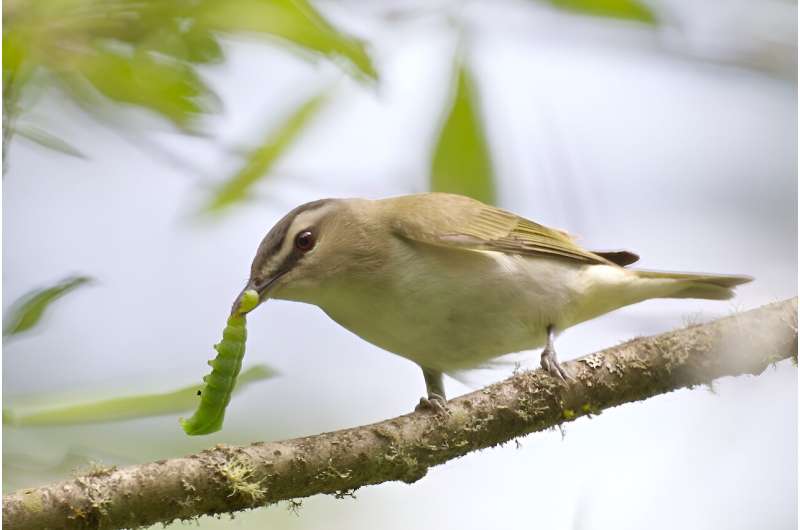
A prevailing opinion in land management is that non-native invasive plants are of no ecological value and they significantly diminish habitat quality for wildlife. Conservation practitioners allocate significant resources to invasive plant removal, often relying on surrounding native plants to passively fill the void. However, evidence that this practice improves food abundance or quality for wildlife is surprisingly limited.
In a new study published in the journal Biological Invasions, researchers in Connecticut, U.S. show that some of the most vilified invasive plants in northeastern U.S. forests may actually be of comparable value to native plants as foraging resources for insectivorous birds, and large-scale invasive plant removal on behalf of these birds may not have the intended benefits.
The research team from Great Hollow Nature Preserve and Ecological Research Center (New Fairfield, CT, U.S.) and Wesleyan University (Middletown, CT, U.S.) conducted a large-scale bird-exclusion experiment in which they compared arthropod biomass and bird foraging intensity among four species of non-native, invasive woody plants and six of the most dominant native species in an 800-acre forest preserve in western Connecticut.
They also measured the protein content (percent elemental nitrogen) of the arthropods on these plants as an indicator of food quality since protein strongly mediates food selection by breeding birds and is critical to offspring development. The study involved the collection, identification, and isotopic analysis of more than 17,000 arthropods from the branches of 240 trees and shrubs, half of which were covered with bird-exclusion netting.
The non-native invasive plants in the study included Japanese barberry, Morrow’s honeysuckle, burning bush, and autumn olive while the natives included striped maple, shadbush, musclewood, witch-hazel, sweet birch, and American beech. In the common stewardship practice of removing invasives without actively planting and fostering natives afterwards, these six native species are among those most likely to fill the void left by invasive plant removal in secondary growth forests in southern New England.
They are therefore among the most realistic alternatives to invasive plants facing managers of such forests, as opposed to oaks, which are generally considered high-quality sources of insect prey for wildlife, but have been regenerating poorly and steeply declining in the eastern U.S. for nearly a century.
Unexpectedly, all lines of evidence in the study suggested the invasive plants were comparable to the natives in their value as foraging resources for birds. Arthropod biomass and protein content were broadly similar between the native and non-native species, and in turn, the birds foraged just as intensively on the non-native plants as they did on the natives.
Non-native honeysuckle stood out as having particularly high prey biomass and quality and frequent visitation by foraging birds, while Japanese barberry generally ranked the lowest.
“Our results indicate that it should first be demonstrated, not assumed, that invasive plants are inferior resources for birds compared to the dominant native plants in the community before land managers undertake costly removal efforts,” said Dr. Chad Seewagen, one of the study’s authors.
“Clearly some invasives are worse than others and it’s not as simple as all invasive plants must go. While we certainly do not suggest that invasive plants have no negative ecological impacts, our study shows that coexisting native plants are not always superior resources for wildlife and that context is important.
“Managers need to know whether the native plants that are most likely to replace removed invasives are really of greater value to the wildlife for which they are managing the habitat, and if that effort is worth the cost and disturbance.”
The study recommends a more nuanced approach to invasive plant management in eastern North American forests, where the services provided by non-native plants are considered against the backdrop of the native plant community in which they have become established.
More information:
Robert E. Clark et al, Invasive plants as a foraging resource for insectivorous birds in a Connecticut, USA forest: insights from a community-level bird-exclusion experiment, Biological Invasions (2024). DOI: 10.1007/s10530-024-03294-6.
Citation:
How bad are invasive plants for birds? Research suggests large-scale removal may not have intended benefits (2024, April 26)
retrieved 26 April 2024
from https://phys.org/news/2024-04-bad-invasive-birds-large-scale.html
This document is subject to copyright. Apart from any fair dealing for the purpose of private study or research, no
part may be reproduced without the written permission. The content is provided for information purposes only.





/cdn.vox-cdn.com/uploads/chorus_asset/file/25437025/ipad_air_larger.png)

